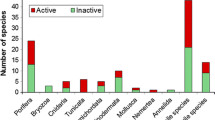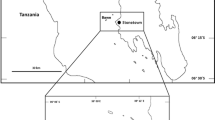Abstract
The feeding-deterrence properties of crude extracts of three Brazilian octocoral species, Neospongodes atlantica Kükenthal (Alcyonacea, Nephtheidae), Plexaurella regia Castro (Gorgonacea, Plexauridae), and Phyllogorgia dilatata Esper (Gorgonacea, Gorgoniidae), were investigated. All the extracts were incorporated into food strips at the concentrations occurring in the living organisms. Crude extract and its ethyl acetate fraction obtained from P. dilatata collected in Armação dos Búzios (Rio de Janeiro State), when incorporated into artificial diets and tested in the habitat of origin, reduced consumption of food strips by fishes, relative to controls. Crude extracts from two octocoral species collected at the National Marine Park of Abrolhos (Bahia State), N. atlantica and P. regia, had no apparent feeding-deterrence properties; in fact, they seemed to stimulate feeding. Bioassay-guided fractionation of the bioactive P. dilatata crude extract revealed that the deterrent property was restricted to a medium polarity fraction. Field palatability experiments with two pure compounds isolated from this fraction revealed that the furanocembranolide 11β,12β-epoxypukalide is a potent feeding deterrent produced by P. dilatata against fish. Apparently, furanocembranolides are a particular class of compounds with feeding deterrent properties, protecting some octocorals from potential fish predator species in both tropical and temperate environments.
Similar content being viewed by others
REFERENCES
Castro, C. B. 1989. A new species of Plexaurella Valenciennes, 1855 (Coelenterata, Octocorallia), from the Abrolhos Reefs, Bahia, Brazil. Rev. Bras. Biol. 49(2):597-603.
Castro, C. B. 1990. Revisão taxonômica dos Octocorallia (Cnidaria, Anthozoa) do Litoral Sul-Americano: Da foz do Rio Amazonas à foz do Rio da Prata. DSc thesis. Universidade de São Paulo, São Paulo, Brazil.
Chan, W. R., Tinto, W. F., Richard, S. L., Manchand, P. S., Reynolds, W. F., and McLean, S. 1991. Cembrane and pseudopterane diterpenoids of the octocoral Pseudopterogorgia acerosa. J. Org. Chem. 56:1773-1776.
Cronin, G., Hay, M. E., Fenical, W., and Lindquist, N. 1995. Distribution, density, and sequestration of host chemical defenses by the specialist nudibranch Tritonia hamnerorum found at high densities on the sea fan Gorgonia ventalina. Mar. Ecol. Prog. Ser. 119:177-189.
Epifanio, R. de A., Maia, L. F., Pinto, A. C., Hardt, I., and Fenical, W. 1998. Natural products from the gorgonian Lophogorgia punicea: Isolation and structure elucidation of an unusual 17-hydroxy sterol. J. Braz. Chem. Soc. 9:187-192.
Epifanio, R. de A., Gabriel, R., Martins, D. L., and Muricy, G. 1999. The sesterterpene variabilin as a fish-predation deterrent in the western Atlantic sponge Ircinia strobilina J. Chem. Ecol. 25:2247-2254.
Faulkner, D. J. 1998. Marine natural products. Nat. Prod. Rep. 2:113-159.
Fenical, W., and Pawlik, J. R. 1991. Defensive properties of secondary metabolites from the Caribbean gorgonian coral Erythropodium caribaeorum. Mar. Ecol. Prog. Ser. 75:1-8.
Fenical, W., Okuda, R. K., Bandurraga, M. M., Culver, P., and Jacobs, R. 1981. Lophotoxin: a novel neuromuscular toxin from Pacific sea whips of the genus Lophogorgia. Science 212:1512-1514.
Fernandes, L., and Kelecom, A. 1995. A further nardosinane sesquiterpene from the gorgonian Phyllogorgia dilatata (Octocorallia, Gorgonacea). An. Acad. Brac. Ci. 67:171-173.
Gerhart, D. J. 1984. Prostaglandin A2: An agent of chemical defense in the Caribbean gorgonian Plexaura homomalla. Mar. Ecol. Prog. Ser. 19:181-187.
Gerhart, D. J., and Coll, J. C. 1993. Pukalide, a widely distributed octocoral diterpenoid, induces vomiting in fish. J. Chem. Ecol. 19:2697-2704.
Harvell, C. D., Fenical, W., and Greene, C. H. 1988. Chemical and structural defenses of Caribbean gorgonians (Pseudopterogorgia spp.). I. Development of an in situ feeding assay. Mar. Ecol. Prog. Ser. 49:287-294.
Hay, M. E., and Fenical, W. 1997. Chemical ecology and marine biodiversity: insights and products from the sea. Oceanography 9:10-19.
Hay, M. E., Satchowicz, J. J., Cruz-Rivera, E., Bullard, S., Deal, M. S., and Lindquist, N. 1998. Bioassays with marine and freshwater macroorganisms, pp. 39-141, in K. F. Haynes and J. C. Millar (eds.). Methods in Chemical Ecology, Volume 2, Bioassay Methods. Chapman and Hall, New York.
Kelecom, A., SolÉ-Cava, A. M., and Kannengieser, G. J. 1980. Occurrence of 23, 24ζ-dimethylcholesta-5,22-dien-3β-ol in the Brazilian gorgonian Phyllogorgia dilatata (Octocorallia, Gorgonacea) and its associated zooxanthella. Bull. Soc. Chim. Belg. 89:1013-1014.
Kelecom, A., Peres, M. B., and Fernandes, L. 1990. A new nardosinane sesquiterpene from the Brazilian endemic gorgonian Phyllogorgia dilatata. J. Nat. Prod. 53:750-752.
Lasker, H. R. 1985. Prey preferences and browsing pressure of the butterflyfish Chaetodon capistratus on Caribbean gorgonians. Mar. Ecol. Prog. Ser. 21:213-220.
Martins, D. L. 1997. Produção de metabólitos secundários contra predadores naturais em octocorais brasileiros: Isolamento, elucidação estrutural e atividade fagorrepelente de produtos naturais da gorgônia Phyllogorgia dilatata. MS thesis. Universidade Federal Fluminense, Rio de Janeiro, Brazil.
Martins, D. L., and Epifanio, R. de A. 1998. A new germacrane sesquiterpene from the Brazilian endemic gorgonian Phyllogorgia dilatata Esper. J. Braz. Chem. Soc. 9:586-591.
Nunan, G. W. 1992. Composition, species distribution and zoogeographical affinities of the Brazilian reef-fishes fauna. PhD thesis. University of Newcastle upon Tyne, Newcastle upon Tyne, England.
Paul, V. J. 1992. Ecological Roles of Marine Natural Products. Comstock Publishing Associates, Ithaca, New York, pp. 164-188.
Pawlik, J. R. 1993. Marine invertebrate chemical defenses. Chem. Rev. 93:1911-1922.
Pawlik, J. R., and Fenical, W. 1989. A re-evaluation of the ichthyodeterrent role of prostaglandins in the Caribbean gorgonian coral Plexaura homomalla. Mar. Ecol. Prog. Ser. 52:95-98.
Pawlik, J. R., and Fenical, W. 1992. Chemical defense of Pterogorgia anceps, a Caribbean gorgonian coral. Mar. Ecol. Prog. Ser. 87:183-188.
Pawlik, J. R., Burch, M. T., and Fenical, W. 1987. Patterns of chemical defense among Caribbean gorgonian corals: a preliminary survey. J. Exp. Mar. Biol. Ecol. 108:55-66.
Schmitz, F. J., Ksebati, M. B., and Ciereszko, L. S. 1984. 11β, 12β-Epoxypukalide, a furanocembranolide from the gorgonian Leptogorgia setacea. J. Nat. Prod. 47:1009-1012.
Van Alstyne, K. L., Wylie, C. R., and Paul, V. J. 1994. Antipredator defenses in tropical Pacific corals (Coelenterata: Alcyonacea) II. The relative importance of chemical and structural defenses in three species of Sinularia. J. Exp. Mar. Biol. Ecol. 178:17-34.
Vreeland, H. V., and Lasker, H. R. 1989. Selective feeding of the polychaete Hermodice carunculata Pallas on Caribbean gorgonians. J. Exp. Mar. Biol. Ecol. 129:265-277.
Wright, A. E., Burres, N. S., and Schulte, G. K. 1989. Cytotoxic cembranoids from the gorgonian Pseudopterogorgia bipinnata. Tetrahedron Lett. 30:3491-3494.
Wylie, C. R., and Paul, V. J. 1989. Chemical defenses in three species of Sinularia (Coelenterata, Alcyonacea): effects against generalist predators and the butterflyfish Chaetodon unimaculatus Bloch. J. Exp. Mar. Biol. Ecol. 129:141-160.
Zar, J. H. 1984. Biostatistical Analysis, 2nd ed. Prentice-Hall, Englewood Cliffs, New Jersey.
Author information
Authors and Affiliations
Rights and permissions
About this article
Cite this article
Epifanio, R.D.A., Martins, D.L., Villaça, R. et al. Chemical Defenses Against Fish Predation in Three Brazilian Octocorals: 11β,12β-Epoxypukalide as a Feeding Deterrent in Phyllogorgia dilatata . J Chem Ecol 25, 2255–2265 (1999). https://doi.org/10.1023/A:1020817722885
Issue Date:
DOI: https://doi.org/10.1023/A:1020817722885




